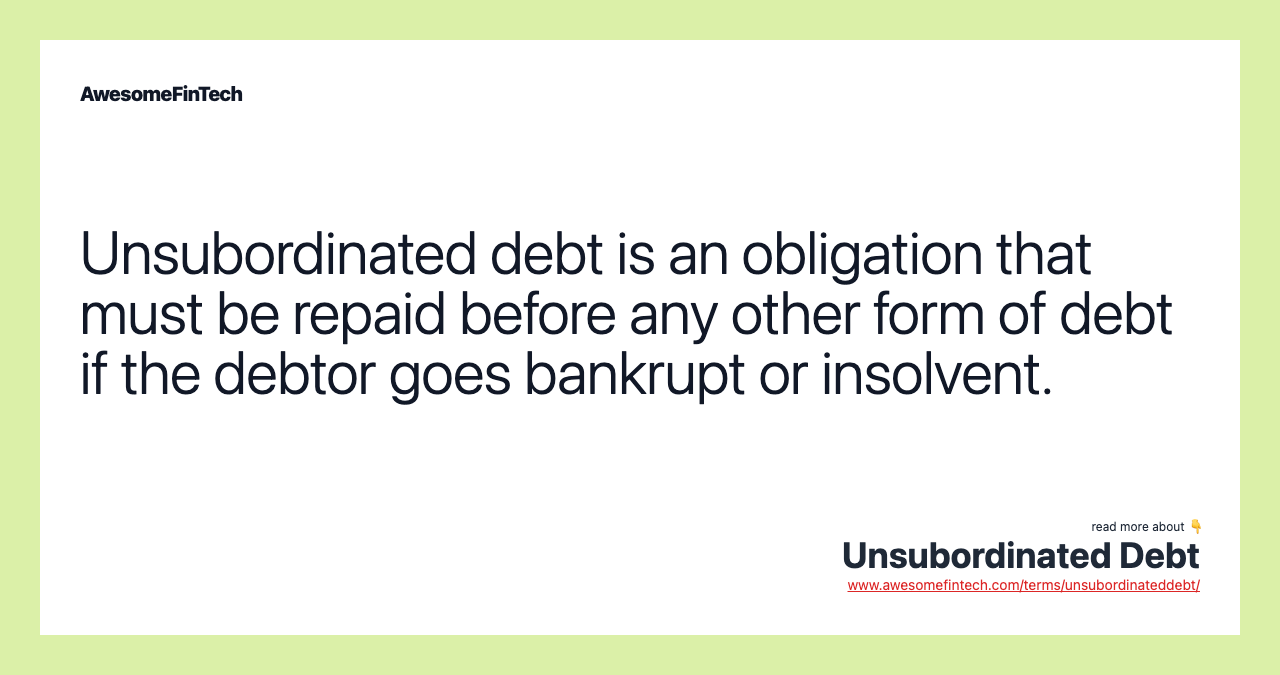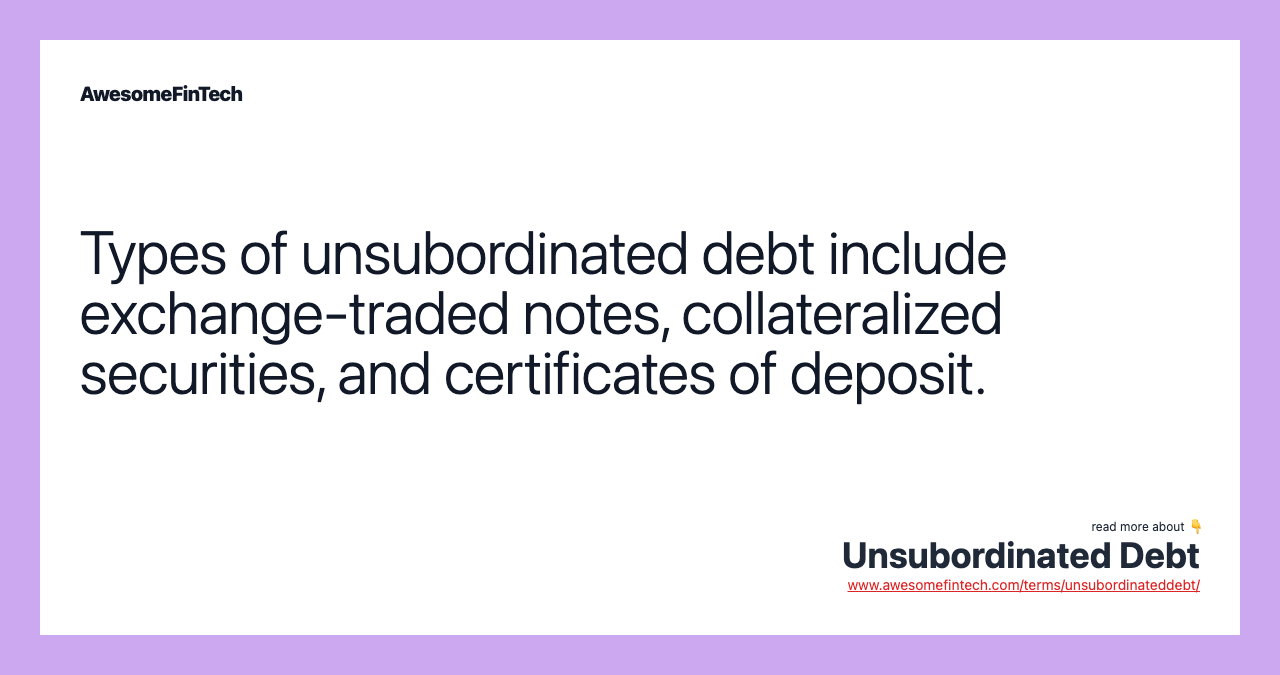Unsubordinated Debt
Unsubordinated debt, also known as a senior security or senior debt, refers to a type of obligation that must be repaid before any other form of debt. When a company’s assets are liquidated to pay off its debt obligations, subordinated debt holders receive payment after all unsubordinated debt lenders and preferred stock holders are paid. Unsubordinated debt, also known as a senior security or senior debt, refers to a type of obligation that must be repaid before any other form of debt. After unsubordinated debt lenders are paid, any remaining money goes to preferred stock holders, subordinated debt, followed by common shareholders. Because there is more risk associated with subordinated debt, these lenders normally charge higher interest rates compared to unsubordinated debt.

What Is Unsubordinated Debt?
Unsubordinated debt, also known as a senior security or senior debt, refers to a type of obligation that must be repaid before any other form of debt. So, holders of unsubordinated debt have the first claim over a company's assets or earnings if the debtor goes bankrupt or insolvent. Because unsubordinated debt comes with a guarantee of repayment, they are considered less risky than other types of debt.




How Unsubordinated Debt Works
When a company goes bankrupt or insolvent, there is normally a chain or ranking of creditors who get paid in a specific order. Lenders of unsubordinated debt get paid out in full first by the company. The majority of this type of debt is usually secured by collateral.
Most loans from financial institutions and certain high-grade debt securities such as mortgage bonds are deemed senior debt. Loans are also considered unsubordinated based on the balance and the length of time outstanding in comparison with other loans.
Because senior debt has a relatively secure claim, it is considered to be less risky. As such, it pays a lower rate of interest compared to other types of debt. This means lenders are willing to compensate for lower borrowing rates by claiming a higher priority over a borrower’s assets since they will be repaid first during a liquidation event.
Because they come with some security, unsubordinated debt lenders normally charge lower interest rates to their debtors.
After unsubordinated debt lenders are paid, any remaining money goes to preferred stock holders, subordinated debt, followed by common shareholders.
Types of Unsubordinated Debt
Examples of unsubordinated debt include exchange-traded notes (ETNs), collateralized securities, and certificates of deposit (CDs). Collateralized securities such as mortgage-backed securities (MBS) are structured with a number of tranches that bear different risks, interest rates, and maturities. Tranches with a higher claim on underlying assets are safer than junior tranches with a second lien. Senior tranches also have a higher credit rating than junior tranches and are paid first.
Unsubordinated vs. Subordinated Debt
Unsubordinated debt is the opposite of subordinated debt. This type of debt vehicle is ranked below all senior debts of a company. Subordinated debt is also called junior debt, and is subject to subordination in the event of default or bankruptcy.
When a company’s assets are liquidated to pay off its debt obligations, subordinated debt holders receive payment after all unsubordinated debt lenders and preferred stock holders are paid. In some cases, there is no cash left after paying the unsubordinated lenders, which means every other creditor remains unpaid.
Because there is more risk associated with subordinated debt, these lenders normally charge higher interest rates compared to unsubordinated debt.
Related terms:
Accounting
Accounting is the process of recording, summarizing, analyzing, and reporting financial transactions of a business to oversight agencies, regulators, and the IRS. read more
Asset
An asset is a resource with economic value that an individual or corporation owns or controls with the expectation that it will provide a future benefit. read more
Bankruptcy
Bankruptcy is a legal proceeding for people or businesses that are unable to repay their outstanding debts. read more
Collateralized Debt Obligation (CDO)
A collateralized debt obligation (CDO) is a complex financial product backed by a pool of loans and other assets and sold to institutional investors. read more
Collateral , Types, & Examples
Collateral is an asset that a lender accepts as security for extending a loan. If the borrower defaults, then the lender may seize the collateral. read more
Equipment Trust Certificate (ETC)
An equipment trust certificate is a debt instrument that allows a company to take possession of an asset and pay for it over time. read more
Exchange-Traded Notes (ETN)
Exchange-traded notes (ETNs) are a type of unsecured debt security that tracks an underlying index of securities and trades on a major exchange like a stock. read more
Junior Equity
Junior equity is corporate stock that ranks at the bottom of the priority ladder when it comes to dividend payments and bankruptcy repayments. read more
Liquidation
Liquidation is the process of bringing a business to an end and distributing its assets to claimants, which occurs when a company becomes insolvent. read more
Mortgage Bond
A mortgage bond is a bond secured by a mortgage on one or more assets, typically backed by real estate holdings and real property, such as equipment. read more